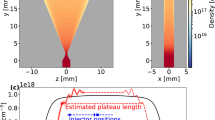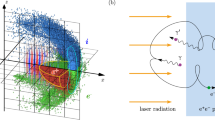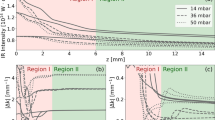Abstract
THERE has been much interest in the recently reported1–4 ionization and breakdown in gases induced by the focused output (∼ 20 MW) of Q-switched lasers. A puzzling feature of the phenomenon is the occurrence5,6 of distinct collinear regions of intense ionization along the laser beam axis near the focal point of the short focal length lenses commonly used in this work. There seems to be no satisfactory explanation of the mechanism producing these quite distinct regions. Considerations based on the development of a radiation supported shock wave7 or travelling ionization waves8 seem to be more appropriate to the later stages of breakdown when the local ionized regions coalesce to form a long spark which appears to be moving. The separate regions of ionization suggest that the spatial distribution of the electric field needed for ionization and created by the focused laser beam has regions of maximum and minimum intensities along the beam axis.
This is a preview of subscription content, access via your institution
Access options
Subscribe to this journal
Receive 51 print issues and online access
$199.00 per year
only $3.90 per issue
Buy this article
- Purchase on Springer Link
- Instant access to full article PDF
Prices may be subject to local taxes which are calculated during checkout
Similar content being viewed by others
References
Terhune, R. W., Proc. Third Intern. Symp. Quantum Electronics, Paris (1963).
Tomlinson, R. G., Damon, E. K., and Buscher, H. T., in Proc. Conf. Physics of Quantum Electronics (edit. by Kelley, P. L., Lax, B., and Tannenwald, P. E.) (McGraw-Hill, NY, 1966).
Young, M., and Hercher, M., J. Appl. Phys., 38, 4393 (1967).
Grey Morgan, C., CERN Report NPA/Int. 67–7 (1967).
Bleeker, J., and Grey Morgan, C., CERN Report NPA/Int. 65–30 (1965).
Mandel'shtam, S. L., Pashinin, P. P., Prokhindeev, A. V., Prokhorov, A. M., and Sukhodrev, N. K., J. Exp. Theor. Phys., 20, 1344 (1965).
Ramsden, S. A., and Savic, P., Nature, 203, 1217 (1964).
Alcock, A. J., DeMichelis, C., Hamal, K., and Tozer, B. A., Phys. Rev. Lett., 20, 1005 (1968).
Born, M., and Wolf, E., Principles of Optics (Pergamon Press, Oxford, 1964).
Bebb, H. B., and Gold, A., Phys. Rev., 143, 1 (1966).
Davidson, P. M., Proc. Roy. Soc., A, 191, 542 (1947).
Basov, N. G., Boiko, V. A., Krohkin, O. N., and Sklizkov, G. V., Soviet Physics–Doklady, 12, 248 (1967).
Chiao, R. Y., Garmire, E., and Townes, C. H., Phys. Rev. Lett., 13, 479 (1964).
Kelley, P. L., Phys. Rev. Lett., 15, 1005 (1965).
Author information
Authors and Affiliations
Rights and permissions
About this article
Cite this article
EVANS, L., MORGAN, C. Multiple Collinear Laser-produced Sparks in Gases. Nature 219, 712–713 (1968). https://doi.org/10.1038/219712b0
Received:
Issue Date:
DOI: https://doi.org/10.1038/219712b0
This article is cited by
Comments
By submitting a comment you agree to abide by our Terms and Community Guidelines. If you find something abusive or that does not comply with our terms or guidelines please flag it as inappropriate.



